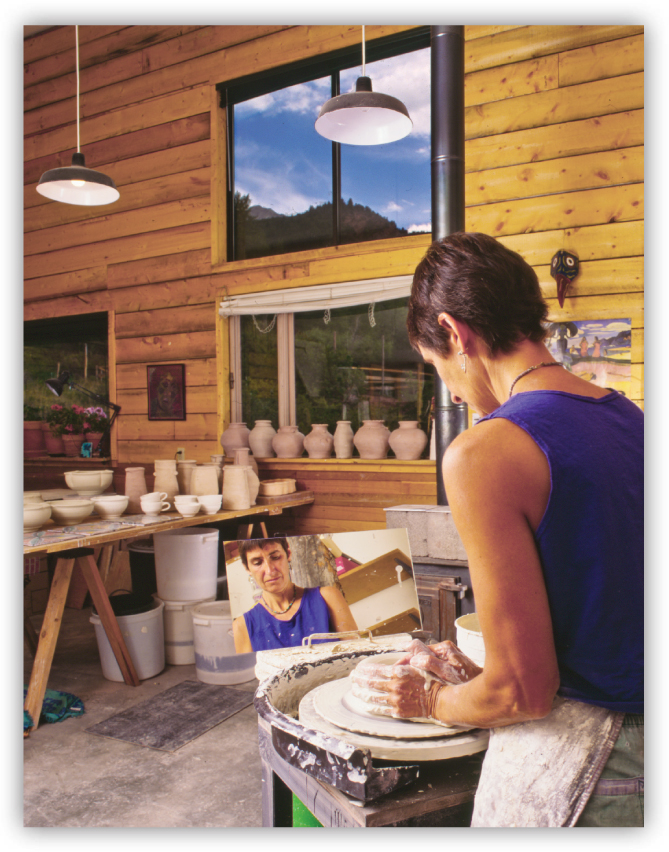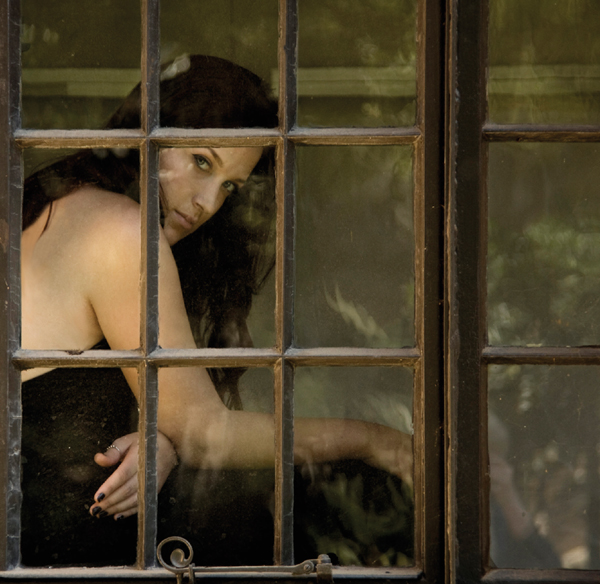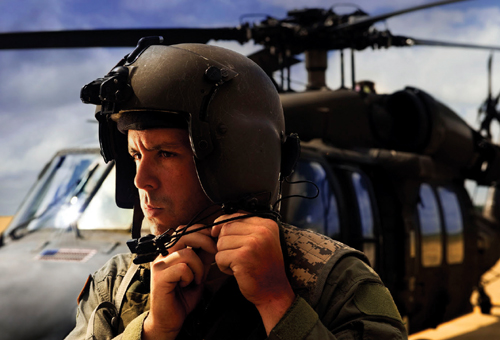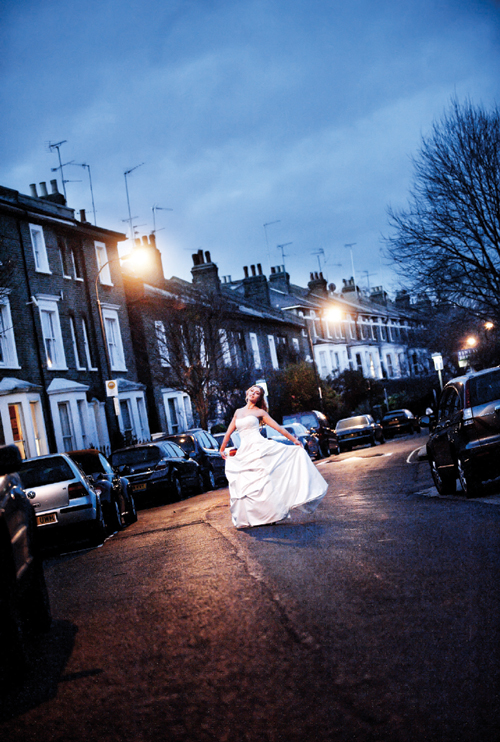10 Mixed Ambient and Electronic Flash Lighting and Exposure

This environmental portrait was made for a Ceramics Monthly magazine cover. The subject used a mirror to make her pottery, so it was used as part of the portrait. Since her studio looked out on the mountains, a decision was made to balance the exposure between electronic flash for the interior and face and the view through the window.
© Glenn Rand
With exposure basics in hand, we can now accomplish some mixed light exposure techniques. We can regard portraits as either studio-lit or mixed light situations. Even within a studio setting, mixed light may be chosen either to use a window as a key light or to provide a creative accent. Many other portrait environments and styles lend themselves to mixed lighting. In most cases, making an outdoor portrait, an environmental portrait, or an editorial illustrative portrait involves mixed light sources and demands greater control of both exposure and lighting.
Many of these situations will involve a mix of ambient light and lighting equipment. This can be as simple as a reflector fill to add light to a outdoor portrait or as complicated as a lit interior and subject with a view out a window. The most complicated setups use artificial lighting along with ambient light in the portrait’s setting.
Since ambient light can serve as either key or fill light, the shutter speed becomes involved whether or not electronic flash is used. Electronic flash presents both potential problems and creative opportunities in these situations. Unless the flash is used only for fill, the shutter speed controls the background’s tone and motion.
Equivalent exposure becomes an important control concept. The exposure control used for electronic flash and the shutter speed combined with aperture controls exposure for ambient light. It allows adjustment of the ambient portion of the exposure to align with the electronic flash. This is the most common paradigm for ambient/flash lighting situations. The use of equivalent exposure in most mixed light situations means that the aperture is set by the key light—whether sunlight, other ambient sources, or electronic flash—and the fill is controlled by equivalent exposure to bring the exposure to the desired ratio. The background tone and motion are controlled by equivalent exposure when the flash is the key light.
Outdoor Lighting and Exposure
Outdoor lighting with electronic flash can be daunting. There are many means for balancing the light output of a strobe with the ambient light available in the scene. Few, however, are consistent from shot to shot. This is the case with battery pack generators or speedlights. Speedlights, often described as the lights that can attach to the hot shoes of most modern cameras, have at least two settings that allow the photographer to balance the flash and ambient light—manual and through-the-lens (TTL). Regardless of the type of lighting equipment, at present, accurate exposure is more readily achieved with the use of manual settings.
© Joyce Wilson
(Courtesy of the artist)
The manual mode allows the photographer to adjust the power output setting on the flash that can then be balanced with the available, ambient light. Today there are no in-camera metering methods for this technique, so most photographers depend upon some combination of viewing the LCD screen on the back of the camera and using clipping indicators or histograms to give them some idea of proper exposure. However, many modern cameras have an advanced method of TTL metering. This uses the camera’s internal metering system and onboard computer to determine correct exposure and the balance of both the ambient and the flash exposures. Though these onboard systems bring the exposures close to optimal, there are situations where TTL settings are inconsistent. Ultimately, many photographers use the LCD screen or use clipping indicators or histograms to make decisions and adjust EV settings to achieve the look they want. With the above in mind, we recommend using a handheld meter to bring consistency and accuracy to the process.
New generation meters have introduced methods of determining ratios between flash and ambient light. Along with the other useful information that the meters provide, they now show the relationship between the intensity of the flash and the ambient light.
Even with a handheld light meter, determining ratios between ambient and flash lighting can be complicated. Ambient exposure in photography is determined by the relationship between shutter speed and aperture. Flash exposure is controlled in-camera by the aperture or by adjusting the power output of the flash. Determining the correct balance between flash and ambient exposures has always been a dance between these two exposure scenarios.
To utilize the available technology and achieve both the proper exposure and desired look in a portrait, several steps are required. First, the ISO setting on the meter needs to be properly aligned with your camera. Next, put the meter in any one of the available strobe modes. Turn on the flash, point the dome of the meter back at the camera, and set off the flash. With the newer meter technology you can measure what percentage of your exposure is coming from the flash. Knowing the relationship of electronic flash and ambient illumination will allow you to determine the key-light source and establish a desired lighting ratio.
In a situation where electronic flash is used with ambient light, the flash can be the key or fill depending on the direction of the light and the strengths of the electronic flash and ambient light source(s). Using a handheld meter allows you to adjust the power of the electronic flash to control the ratio regardless of whether it is the key or fill.
This ability to choose whether the ambient or electronic flash will be key gives you great flexibility in determining the style of your portraits. By using a handheld meter and changing the power settings on the electronic flash, you can control the ratios in your portraits and determine the style and look of the portraits by adjusting which source, ambient or electronic flash, will be dominant.
Billy Casper © Tim Mantoani (Courtesy of the artist)
© Stacy Pearsall (Courtesy of the artist)
Backlit Outdoor Situations
A strongly backlit setting, such as a portrait with a sunset in the background, creates its own unique lighting and exposure concerns. Beyond the potential of flare in the camera, a backlit situation means that the face may be naturally flattened. In addition, the ambient lighting will have no LD Edge with a 1:1 ratio.
A flash fill increases the flattening potential, particularly when the flash is on-camera or in a traditional behind-the-camera position. The additional light opens the tonality of the face but does not add dimension. If an electronic flash is used at an angle, then this light replaces the sun as the key light and creates an LD Edge and light ratio between the light and ambient fill.
If the electronic flash vastly overpowers the sunlight, the resulting image can take on an unnatural look. When an electronic flash is used at an angle, care should be taken to keep it at a consistent angle with the sun. If the sun or the angle of the light is visible in the frame, the new key light should be on the same side of the frame and at a similar angle to ensure a more natural look. It is important to use diffused light and to keep the lighting ratio low, less than 1:4.
In a backlit portrait setting, the background has noticeable effects. Vertical surfaces are silhouetted and darkened, while horizontal surfaces are bright and potentially glaring.
The exposure for a heavily backlit situation depends on the tone desired for the background. It is helpful to perform a reflective meter reading of the background and then determine the exposure for the shutter speed and aperture. At this point, the angular electronic flash reading is taken. If a natural look is desired, the power for the flash unit should be set to an aperture equal to or one stop less than the f-stop resulting from the background exposure. If you cannot power down the key light flash to an acceptable aperture, then an equivalent exposure can be used to adjust the shutter speed for an f-stop within the light range the flash unit can produce. Any fill should be set using the additive method, whether you are using a flash unit, reflector, or ambient light.
Expanded Range Situations
In outdoor situations with bright sunlight, the light’s dynamic range may be too great for you to effectively print both the portrait and the sunlit background. Neither normal digital capture nor traditional negative-to-print processing can adequately present the totality of the photographic information. This situation suggests the use of a longer dynamic range. For film cameras with color negative film, the range is about 18 stops. For digital cameras, it is necessary to use digital output that allows the separation of tones across a wide range. While it is possible to do high dynamic range imaging (HDRI) with digital capture, presently these techniques consist of scanning technology or multiple exposures that are not appropriate for portrait photography.
Digital capture is particularly unable to accept overexposure. This is one area where negative film has an advantage. Using film’s latitude for overexposure results in a negative that has all the information needed for facial details, deep shadow details, and bright sunlit areas. It is necessary to make two scans of the negative, one for the highlight areas and one for the darker areas. These two scans are then merged, either manually or by using software such as HDRI Merge in Photoshop, to produce one file that includes all the long dynamic range infomation.
Indoor/Outdoor Situations
For environmental or editorial illustrative portraits, we often find the need to light an interior with our subject and at the same time see through a window to capture the exterior view. Here the approach is to light the interior and the subject first and then calculate the exposure based on the combination of interior and exterior lighting. When the interior lighting is an electronic flash with the exposure based on the aperture, it can be balanced with an equivalent exposure for the exterior light at the same f-stop. The f-stop is calculated by metering the interior electronic flash. Regardless of whether the exposure for the exterior light is determined by metering or by using BDE, the equivalent exposure has the same f-stop as the interior lighting provided by the electronic flash.
This bridal image was shot outdoors using lighting from the sky and streetlights
© Art P. Suwansang (Courtesy of the artist)




